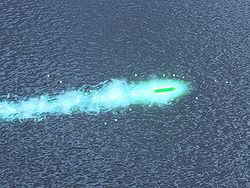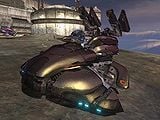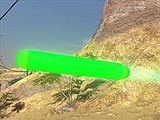Fuel rod: Difference between revisions
From Halopedia, the Halo wiki
No edit summary |
No edit summary |
||
| Line 1: | Line 1: | ||
{{Era|Covenant|HCW}} | {{Era|Covenant|HCW}} | ||
[[File:1211317365 Fuel Rod.jpg|thumb|250px|A fuel rod in mid-flight.]] | [[File:1211317365 Fuel Rod.jpg|thumb|250px|A fuel rod in mid-flight.]] | ||
'''Fuel rod''' is a colloquial name for a form of explosive munitions used in several [[Covenant]] weapon systems.<ref name="vis">'''[[Halo: The Essential Visual Guide]]''', ''page 77''</ref> Fuel rods are caseless, transparent projectiles,<ref name="vis"/> containing green, radioactive material.<ref>[http://www.bungie.net/projects/halo3/content.aspx?link=h3fuelrod '''Bungie.net''' - ''Type-33 Light Anti-Armor Weapon'']</ref> Once they strike the target, the radioactive materials contained in the projectile detonate. | '''Fuel rod''' is a colloquial name for a form of explosive munitions used in several [[Covenant]] weapon systems.<ref name="vis">'''[[Halo: The Essential Visual Guide]]''', ''page 77''</ref> Fuel rods are caseless, transparent projectiles,<ref name="vis"/> containing green, radioactive material.<ref name="t33laaw">[http://www.bungie.net/projects/halo3/content.aspx?link=h3fuelrod '''Bungie.net''' - ''Type-33 Light Anti-Armor Weapon'']</ref> Once they strike the target, the radioactive materials contained in the projectile detonate. | ||
Fuel rods come in several types, including Class-2 and Class-3. The Class-2 fuel rods are unguided, 38mm in diameter, and are used in the [[Type-33 Light Anti-Armor Weapon]].<ref name="vis"/> The [[fuel rod cannon]]s mounted on the [[Type-52 Anti-Aircraft Artillery|Anti-air Wraith]] and the [[Type-26 Ground Support Aircraft|Banshee]] use the heavier Class-3 fuel rods, which have a greater range and a capability to track heat signatures.<ref>'''Halo: The Essential Visual Guide''', ''page 9''</ref> The rounds fired by the [[Type-51 Carbine]] are similar to fuel rods, on a smaller scale and without their explosive effects. | Fuel rods come in several types, including Class-2 and Class-3. The Class-2 fuel rods are unguided, 38mm in diameter, and are used in the [[Type-33 Light Anti-Armor Weapon]].<ref name="vis"/> The [[fuel rod cannon]]s mounted on the [[Type-52 Anti-Aircraft Artillery|Anti-air Wraith]] and the [[Type-26 Ground Support Aircraft|Banshee]] use the heavier Class-3 fuel rods, which have a greater range and a capability to track heat signatures.<ref>'''Halo: The Essential Visual Guide''', ''page 9''</ref> The rounds fired by the [[Type-51 Carbine]] are similar to fuel rods, on a smaller scale and without their explosive effects. | ||
| Line 7: | Line 7: | ||
Fuel rods are most often used in an anti-armor or anti-air role, but are also devastatingly effective against infantry.<ref name="vis"/> They are essentially the Covenant equivalent to the [[United Nations Space Command|UNSC]]'s [[M19 surface-to-surface missile]]s. | Fuel rods are most often used in an anti-armor or anti-air role, but are also devastatingly effective against infantry.<ref name="vis"/> They are essentially the Covenant equivalent to the [[United Nations Space Command|UNSC]]'s [[M19 surface-to-surface missile]]s. | ||
Rumors surround fuel rods, with many UNSC Marines under the apparent belief that even carrying a weapon that uses them for ammunition can cause [[Boren's Syndrome]].<ref>[http://www.bungie.net/projects/halo3/content.aspx?link=h3carbine '''Bungie.net''' - ''Type-51 Carbine'']</ref> | Though widely used among UNSC personnel, "fuel rod" is actually an informal term supposedly originating from common popular culture depictions of nuclear fuel rods.<ref name="t33laaw"/> Rumors surround fuel rods, with many UNSC Marines under the apparent belief that even carrying a weapon that uses them for ammunition can cause [[Boren's Syndrome]].<ref>[http://www.bungie.net/projects/halo3/content.aspx?link=h3carbine '''Bungie.net''' - ''Type-51 Carbine'']</ref> | ||
==Gallery== | ==Gallery== | ||
Revision as of 08:01, October 5, 2011
Fuel rod is a colloquial name for a form of explosive munitions used in several Covenant weapon systems.[1] Fuel rods are caseless, transparent projectiles,[1] containing green, radioactive material.[2] Once they strike the target, the radioactive materials contained in the projectile detonate.
Fuel rods come in several types, including Class-2 and Class-3. The Class-2 fuel rods are unguided, 38mm in diameter, and are used in the Type-33 Light Anti-Armor Weapon.[1] The fuel rod cannons mounted on the Anti-air Wraith and the Banshee use the heavier Class-3 fuel rods, which have a greater range and a capability to track heat signatures.[3] The rounds fired by the Type-51 Carbine are similar to fuel rods, on a smaller scale and without their explosive effects.
Fuel rods are most often used in an anti-armor or anti-air role, but are also devastatingly effective against infantry.[1] They are essentially the Covenant equivalent to the UNSC's M19 surface-to-surface missiles.
Though widely used among UNSC personnel, "fuel rod" is actually an informal term supposedly originating from common popular culture depictions of nuclear fuel rods.[2] Rumors surround fuel rods, with many UNSC Marines under the apparent belief that even carrying a weapon that uses them for ammunition can cause Boren's Syndrome.[4]
Gallery
List of appearances
- Halo: Combat Evolved (First appearance)
- Halo 2
- Halo 3
- Halo 3: ODST
- Halo: Reach
- Halo: The Flood
- Halo: First Strike
- Halo: Graphic Novel
- Halo: Helljumper
- Halo Legends
Sources
- ^ a b c d Halo: The Essential Visual Guide, page 77
- ^ a b Bungie.net - Type-33 Light Anti-Armor Weapon
- ^ Halo: The Essential Visual Guide, page 9
- ^ Bungie.net - Type-51 Carbine


